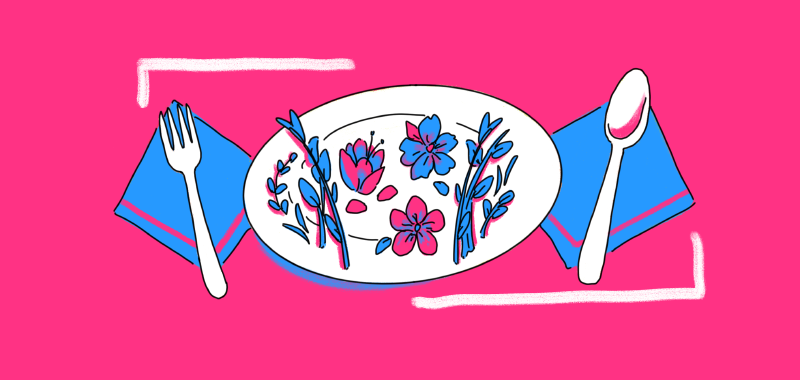
Good Eats - Flowers
Denise “The Vamp DeVille” Zubizarreta, Creative Team Member
June 30, 2023
It may be trendy to stuff a squash blossom, but it’s really nothing new. For centuries, cultures around the globe have enhanced their recipes with flowers. In Roman times, roses were used for cooking, flavoring food. Rosewater was also added to fountains and baths thanks to its astringent properties and ability to cleanse and tone the skin whilst maintaining pH balance. For flowers that look good as well as taste good, consider some of the following:
Hibiscus
Hibiscus plants produce large, ornate blossoms that usually grow in tropical and subtropical climates around the world. Hundreds of hibiscus species exist, but the most popular edible variety is known as roselle or Hibiscus sabdariffa. They can grow as large as 6 inches (15 cm) in diameter and are found in a wide array of colors, including red, white, yellow and various shades of pink. You can eat the flower directly from the plant, but most of the time we see it used for teas, salads, and jams. Studies such as “Effect of sour tea (Hibiscus sabdariffa L.) on arterial hypertension” and “A review on phytochemistry and therapeutic uses of Hibiscus sabdariffa L” indicate that hibiscus may help reduce blood pressure, cholesterol levels, and can be an overall great addition for those focused on heart health.
Honeysuckle
The sweetly-scented blossoms of honeysuckle shrubs are a hallmark of summertime. They are typically yellow or white, and are famous for containing nectar that can be “suckled” straight from the flower. There are over 180 species of these flowering shrubs that can be found across North America and Eurasia. Honeysuckle has found use in traditional Chinese medicine, often used to treat fever, cough, sore throat, tonsillitis, and pharyngitis. It is purported to have a variety of beneficial health effects, and although the hard science is scant, according to WebMD, it may have antiviral properties and antioxidants. While the honeysuckle flower and its nectar are safe to eat, the berries of some varieties may be toxic if ingested in large quantities, so proceed with caution when adding honeysuckle to your menu.
Squash Blossom
If you’ve been to a trendy gastro-pub in the last decade, you’ve most likely seen these bright blooms stuffed with cheese and fried to a golden crisp. Although this preparation is so popular that it has captured the imagination of foodies from coast to coast, they’re also tasty raw. Their flavor is delicate and easily overpowered, so if you’re looking to explore their natural flavor, don’t feel obligated to fuss over textural contrast and flavor pairings. Although these flowers form on all types of summer squash, the most popular are the zucchini’s long, yellow, bell-shaped blossoms. You don’t have to sacrifice your squash harvest to enjoy eating these flowers. Only the female blossoms can turn into squash, so stick to eating the male flowers to ensure a full harvest. The male flowers have a long, thin stem and typically grow around the outer edges of the plant. Female flowers tend to grow closer to the plant’s center and have a small, bulbous fruit at the base of the blossom where it meets the stem. As an added bonus, squash blossoms contain folate, a B-vitamin that supports neurological development, as well as small amounts of protein, and a number of trace minerals that contribute to the healthy function of many body systems.
Pansy
Aside from being a vibrant addition to a meal, pansies are also a rich source of several potent plant compounds known to have antioxidant and anti-inflammatory properties. Though there are many color variations, pansies most commonly grow in hues of purple, blue, and yellow. Typically, pansies have a mild, fresh and lightly floral flavor, but there is some flavor variation depending on the type. They lend themselves well to being candied so they’re perfect for desserts that need a little extra flair. Flowering pansy herb is also used externally to treat mild seborrheic skin diseases such as dandruff, itching, cradle cap and acne. The plant is also thought to be able to purify the blood and stimulate the metabolism. This impressive flower could be a great addition for a pre-workout snack.
Purslane
This succulent has risen in popularity thanks to its rich nutrient content. It’s filled with vitamins, minerals and antioxidants, but its biggest claim to nutritional fame is its omega-3 fat content. In fact, purslane provides more omega-3s than almost any other vegetable of its kind. Served raw, sautéed, steamed or fried, purslane makes a great side dish or addition to soups, stews, and casseroles. It has also been used as a purgative, cardiac tonic, emollient, muscle relaxant, anti-inflammatory and diuretic treatment in herbal medicine. Purslane has also been used in the treatment of osteoporosis and psoriasis.
Flowers offer much more than dining table decoration and yard envy. They are powerful and natural remedies, delicious and nutritious snacks, and even a sweet treat to reward yourself after a long day. Whether you’re looking to create homemade, all-natural skincare products or you’re interested in expanding your culinary horizons, the first step is investigating plants you can easily grow in your own yard or home. Not only are they cost effective, easily accessible, and potentially healthy, according to Healthline, “the global demand for herbal remedies is on the rise. In fact, it’s estimated that this industry grosses about $60 billion annually.” So, the next time you’re preparing to plant some visually pleasing petals, think about planting the ones that have a plethora of impactful uses and properties, you never know when they might come in handy.

No one has commented yet. Be the first!